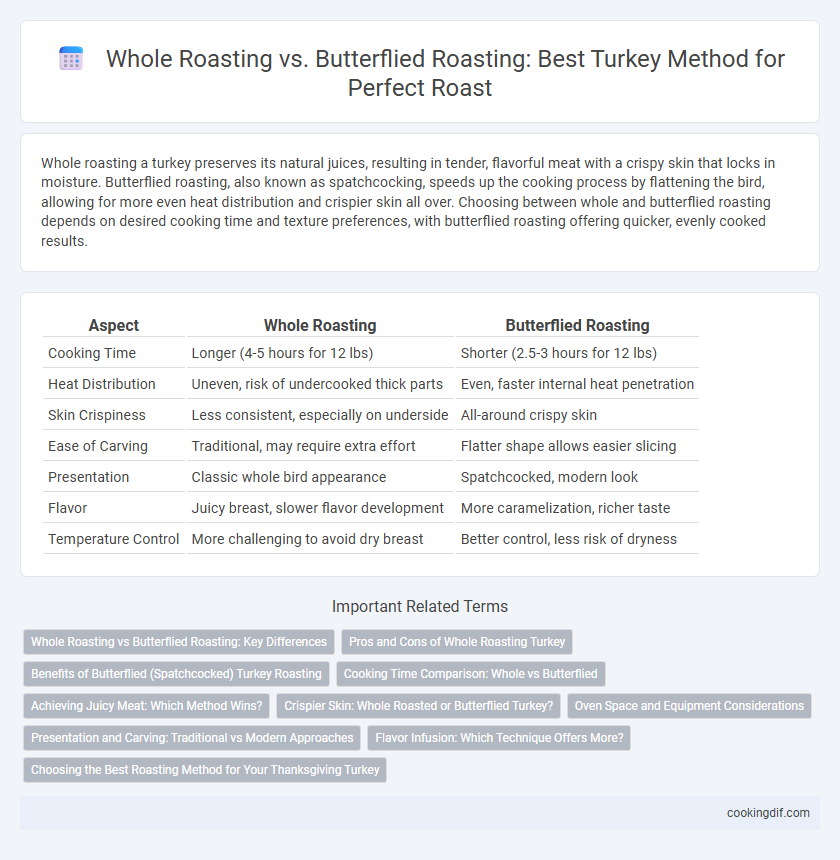Whole roasting a turkey preserves its natural juices, resulting in tender, flavorful meat with a crispy skin that locks in moisture. Butterflied roasting, also known as spatchcocking, speeds up the cooking process by flattening the bird, allowing for more even heat distribution and crispier skin all over. Choosing between whole and butterflied roasting depends on desired cooking time and texture preferences, with butterflied roasting offering quicker, evenly cooked results.
Table of Comparison
| Aspect | Whole Roasting | Butterflied Roasting |
|---|---|---|
| Cooking Time | Longer (4-5 hours for 12 lbs) | Shorter (2.5-3 hours for 12 lbs) |
| Heat Distribution | Uneven, risk of undercooked thick parts | Even, faster internal heat penetration |
| Skin Crispiness | Less consistent, especially on underside | All-around crispy skin |
| Ease of Carving | Traditional, may require extra effort | Flatter shape allows easier slicing |
| Presentation | Classic whole bird appearance | Spatchcocked, modern look |
| Flavor | Juicy breast, slower flavor development | More caramelization, richer taste |
| Temperature Control | More challenging to avoid dry breast | Better control, less risk of dryness |
Whole Roasting vs Butterflied Roasting: Key Differences
Whole roasting a turkey preserves its natural juices by cooking the bird intact, ensuring a moist interior and crispy skin on the outside. Butterflied roasting, also known as spatchcocking, involves removing the backbone and flattening the turkey for faster, more even cooking and increased surface area for seasoning and browning. The choice between whole roasting and butterflied roasting impacts cooking time, texture, and flavor development, with whole roasts offering traditional presentation and butterflied roasts providing quicker, more consistent results.
Pros and Cons of Whole Roasting Turkey
Whole roasting a turkey preserves moisture and enhances flavor by cooking the bird intact, ensuring the skin crisps evenly and juices remain locked inside. This method requires longer cooking times and even heat distribution to prevent uneven doneness, particularly around thicker parts like the breast and thigh. It offers a traditional presentation ideal for occasions but can result in slower carving and less surface area for marinade absorption.
Benefits of Butterflied (Spatchcocked) Turkey Roasting
Butterflied (spatchcocked) turkey roasting enables faster and more even cooking by flattening the bird, which exposes a larger surface area to heat. This method reduces the risk of drying out breast meat while achieving crispy skin due to better heat circulation. The turkey also cooks more uniformly, enhancing flavor and texture throughout the dish.
Cooking Time Comparison: Whole vs Butterflied
Whole roasting a turkey typically requires 3 to 4 hours at 325degF, depending on weight, while butterflied roasting reduces cooking time by approximately 25-30%, often completing in 2 to 2.5 hours. The increased surface area and even thickness of a butterflied turkey allow for faster, more uniform heat penetration, minimizing hot spots. Butterflied roasting also promotes crispier skin and juicier meat through quicker cooking at higher temperatures.
Achieving Juicy Meat: Which Method Wins?
Whole roasting preserves the turkey's natural juices by cooking it intact, minimizing surface area exposure and retaining moisture within the bird. Butterflied roasting, or spatchcocking, increases even heat distribution and reduces cooking time, which can help prevent dryness if done correctly. Achieving juicy meat depends on balancing cooking time and temperature, with whole roasting offering traditionally moister results while butterflied roasting excels in consistent doneness and faster cooking.
Crispier Skin: Whole Roasted or Butterflied Turkey?
Butterflied turkey typically achieves crispier skin due to increased surface area exposure and more even heat distribution during roasting. Whole roasting often results in moister meat but can produce less uniformly crisp skin, especially on the thicker breast area. For maximum crispiness, butterflied roasting allows better airflow and rendering of fat beneath the skin, enhancing texture and flavor.
Oven Space and Equipment Considerations
Whole roasting a turkey requires a larger oven space and often a deeper roasting pan to accommodate the bird's full size, which can limit capacity for additional dishes. Butterflied roasting, also known as spatchcocking, significantly reduces the turkey's thickness, allowing it to lay flat and fit more easily in smaller ovens or pans, optimizing oven space. This method also promotes even cooking and requires less specialized equipment compared to whole roasting.
Presentation and Carving: Traditional vs Modern Approaches
Whole roasting turkey offers a classic presentation with an intact, golden-brown exterior that enhances visual appeal and suits traditional holiday settings. Butterflied roasting exposes more surface area, promoting even cooking and creating a flatter shape that facilitates easier, uniform carving, ideal for modern, casual gatherings. Both methods influence carving techniques: whole roasting requires precise slicing around joints, while butterflied turkey allows for straightforward, quicker portioning.
Flavor Infusion: Which Technique Offers More?
Whole roasting a turkey preserves natural juices, allowing the meat to baste itself and develop a rich, concentrated flavor throughout. Butterflied roasting exposes more surface area, enabling marinades and rubs to penetrate deeply, resulting in enhanced seasoning and crispier skin. For maximum flavor infusion, butterflied roasting offers superior benefits by improving heat distribution and seasoning absorption.
Choosing the Best Roasting Method for Your Thanksgiving Turkey
Whole roasting preserves the turkey's natural juices and results in a classic, evenly cooked bird with crispy skin, ideal for traditional Thanksgiving presentations. Butterflied roasting, or spatchcocking, speeds up cooking time and promotes more consistent heat distribution, reducing dry spots while allowing for extra seasoning exposure. Choosing the best roasting method depends on your preference for texture, cooking time, and ease of carving for your Thanksgiving turkey.
Whole Roasting vs Butterflied Roasting for Turkey Infographic

 cookingdif.com
cookingdif.com